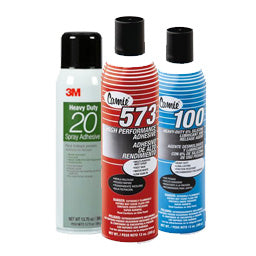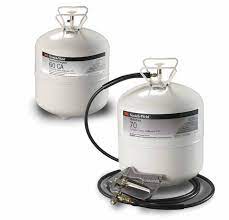Table of Contents:
- What is Methylene Chloride?
- Methylene Chloride in Adhesives
- Banning Adhesives with Methylene Chloride
- Adhesive Alternatives to Methylene Chloride
Adhesives are an important part of the manufacturing process. They can be used in everything from the assembly of upholstery to the solvent welding of plastics. They also come in various chemistries and have different makeups. But in some cases, the adhesive that companies have been using for decades has come into question in terms of the safety of its chemical makeup. Methylene chloride-based adhesives are one such example that has been making headlines and is currently on its way out.
What is Methylene Chloride?
Methylene chloride, also known as dichloromethane or DCM, is a nonflammable, colorless liquid and volatile chemical. It has a distinct odor that is described as sweet or similar to chloroform. Methylene chloride is commonly used in solvent welding plastics, paint stripping, pharmaceutical manufacturing, and adhesive formulation.
While it can have many applications, there are also several dangers of methylene chloride to humans. Short-term exposure to methylene chloride can lead to issues like nausea, dizziness, headaches, or skin irritation. Long-term side effects of methylene chloride exposure that is repeated or frequent may lead to health problems such as memory loss, depression, dermatitis, and different cancers.1
Methylene Chloride in Adhesives
One of the more common applications for methylene chloride is in the formulation of solvent-based adhesives. The methylene chloride acts as a carrier solvent that prevents the adhesive from bonding until it is dispensed and applied to a surface. It can also help improve the adhesive's surface wetting capabilities. Once applied, the methylene chloride will evaporate, and the bond will form. It works especially well with foam, plastics, and rubbers.
Using methylene chloride in adhesives is so common because it is one of the few readily available nonflammable solvents that still offers a strong performance. This nonflammable property makes it much easier to work with for businesses as no special handling, storage, or safety protocols are required.
Banning Adhesives with Methylene Chloride
Although methylene chloride glues have their advantages, the potential health effects have led to the banning of methylene chloride in adhesives and other products. In April 2024, the Environmental Protection Agency (EPA) issued a formal notice on the finalized ban of methylene chloride for most applications. While some highly specialized applications are exempt, most businesses that manufacture, process, or distribute consumer products containing methylene chloride will need to comply.

The press release noted, "While EPA banned one consumer use of methylene chloride in 2019, use of the chemical has remained widespread and continues to pose significant and sometimes fatal danger to workers. EPA's final risk management rule requires companies to rapidly phase down manufacturing, processing and distribution of methylene chloride for all consumer uses and most industrial and commercial uses, including its use in home renovations."2 The ban also comes with new worker protections that try to limit exposure to methylene chloride for workers for applications where the chemical is still used.
While the notice was issued in April 2024, the ban did not go into effect immediately. Consumer use was set to be phased out within a year, while commercial uses had a two-year deadline. In May 2025, the EPA filed a proposal for an extension for compliance dates. The final dates are still to be determined, but the expectation is that compliance with the ban will still be expected, if just slightly delayed.
Adhesive Alternatives to Methylene Chloride
With the ban on methylene chloride adhesive glues, some businesses have been scrambling to find safe, but still effective alternative solutions. Our team shares a few alternatives to methylene chloride adhesives that you can look into.
1. Alternative Solvent-Based Adhesives
There are some methylene chloride-free, solvent-based adhesives. The biggest benefit to these products is that they tend to be the closest in performance to methylene chloride-based adhesives in tack and bond strength. They also usually have a similar application process for an easier transition. Their big downfall is that they are flammable. Because of this, companies using them have to meet strict regulations related to storage and handling.
Some alternative solvent-based adhesives we recommend trying are the 3M Super 77, 3M HoldFast 70 spray adhesive, and 3M 94 CA spray adhesive.
2. Two-Component, Water-Based Adhesives
These adhesives are free of methylene chloride and have no dangerous VOCs, so they are a more environmentally friendly option. They are also non-flammable. They can achieve similar tack to that of a solvent-based adhesive, but they may have a decreased performance. On top of potential performance drop-offs, they also require mixing before application which involves more complex dispensing and often specialized equipment.
A two-component water-based adhesive we recommend trying is the Fastbond 1049. This adhesive won the 2025 Innovation Award from The Adhesive and Sealant Council.
3. One-Component, Water-Based Adhesives
Like their two-component counterparts, these adhesives do not have methylene chloride or hazardous VOCs and are non-flammable. They tend to have similar bonding abilities to solvent-based adhesives. The potential tradeoff with these adhesives is that they tend to have decreased tack and longer drying times than solvent-based adhesives. This can significantly increase the processing time.
While traditionally these products may not have been the best alternative to methylene chloride adhesives, there have been some more recent advancements in adhesive technology. New products have been developed to fill this gap and reduce the number of trade-offs for companies looking to comply with the methylene chloride adhesive ban.
3M has a series of water-based adhesives that perform like solvent-based adhesive, including Fastbond 1100NF. These products are solvent-free as well as non-flammable.
While these products may not serve as direct replacements for every methylene chloride adhesive, they are promising options for foam applications in particular and may help bridge the performance gap for certain companies.
Find An Alternative for Your Needs
Do not wait any longer to find a methylene chloride-free adhesive for your application. If you are not sure if one of these products is right for you or think you need another alternative, let us know. We have a wide range of products, not all of which are online, that may be best suited for your application. We can also provide you with a no-obligation, customized product recommendation. Get started.
Sources:
1. California Department of Public Health. Methylene Chloride










